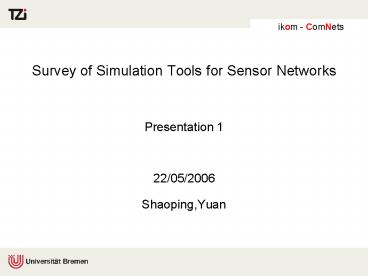Survey of Simulation Tools for Sensor Networks - PowerPoint PPT Presentation
1 / 16
Title:
Survey of Simulation Tools for Sensor Networks
Description:
Noninteractive, data and event centric applications ... Mantis. Contiki. SOS. ikom - ComNets. Other commercial platforms. Cube. Phidgets. ikom - ComNets ... – PowerPoint PPT presentation
Number of Views:55
Avg rating:3.0/5.0
Title: Survey of Simulation Tools for Sensor Networks
1
Survey of Simulation Tools for Sensor Networks
- Presentation 1
- 22/05/2006
- Shaoping,Yuan
2
WSNWireless Sensor Network
- Noninteractive, data and event centric
applications - Application specific
- Deployed in uncontrolled, often inaccessible
- Energy usage must be carefully managed
- Closed environment, sensors rarely change
- Fixed sensors but dynamic topology
- Some need for real time delivery and time
synchronization
3
Challenges
- Distributed processing
- Low bandwidth communication
- Large scale coordination
- Real time computation
4
Operation system support
- TinyOS
- Mantis
- Contiki
- SOS
5
Other commercial platforms
- Cube
- Phidgets
6
TOSSIM
- Emulator run actual application code
- Component-based, discrete event simulator
- Focus on TinyOS and its execution
- Simulate at bit-level
- Four key points scalability, completeness,
fidelity, bridging - Static simulator
- TinyViz a Java visualzation and actuation
environment for TOSSIM
7
Problems of TOSSIM
- Probabilistic bit error model leads to
inaccuracies and reduces the effectiveness in
anylyzing low level protocols - Built directly from TinyOS code
- API application programming interface
8
TOSSIM (with MULE)Mobile Ubiquitous LAN
Extensions
- Motivation sensors may be spread over a large
geographical area resulting in a sparse network - Possible approaches install multiple base
stations to relay the data from sensor nodes in
their coverage area or deploy enough low-power
relay nodes to form a dense connected network - Advantage large power saving
- Disadvantage increased latency
- Conclusion MULE archtecture is suitable for a
rich set of environmental monitoring applications
in urban environments, both in low and high
mobility scenarios
9
OPNET
- Simulator
- Discrete event, object-oriented
- Modeling and simulatio of ultra large networks
- Hierachical model define each aspect of the
system - Top level network model, topology is
designed - Next level node model, data flow models are
defined - Third level process editor, handlles control
flow models - Fourth level parameter editor, to support
the three higher - layers
10
Problems of OPNET
- Scalability
- Not enough protocols available
- Only available in commercial form
11
Comparision of different tools
12
Comparision of different tools
13
Comparision of different tools
14
Comparision of different tools
15
Others
- Avrora a cycle-accuracy instruction-level sensor
network simulator, be able to measure detailde
time-critical phenomena - Emstar an environment for developing wireless
embedded system software - SENS a sensor, environment and network
simulator - WSNS
- Ptolemy
- WISENES
- Sunflower
16
Reference
- www.elet.polimi.it/picco
- http//ieeexplore.ieee.org
- http//en.wikipedia.org
- http//www.binghamton.edu/































